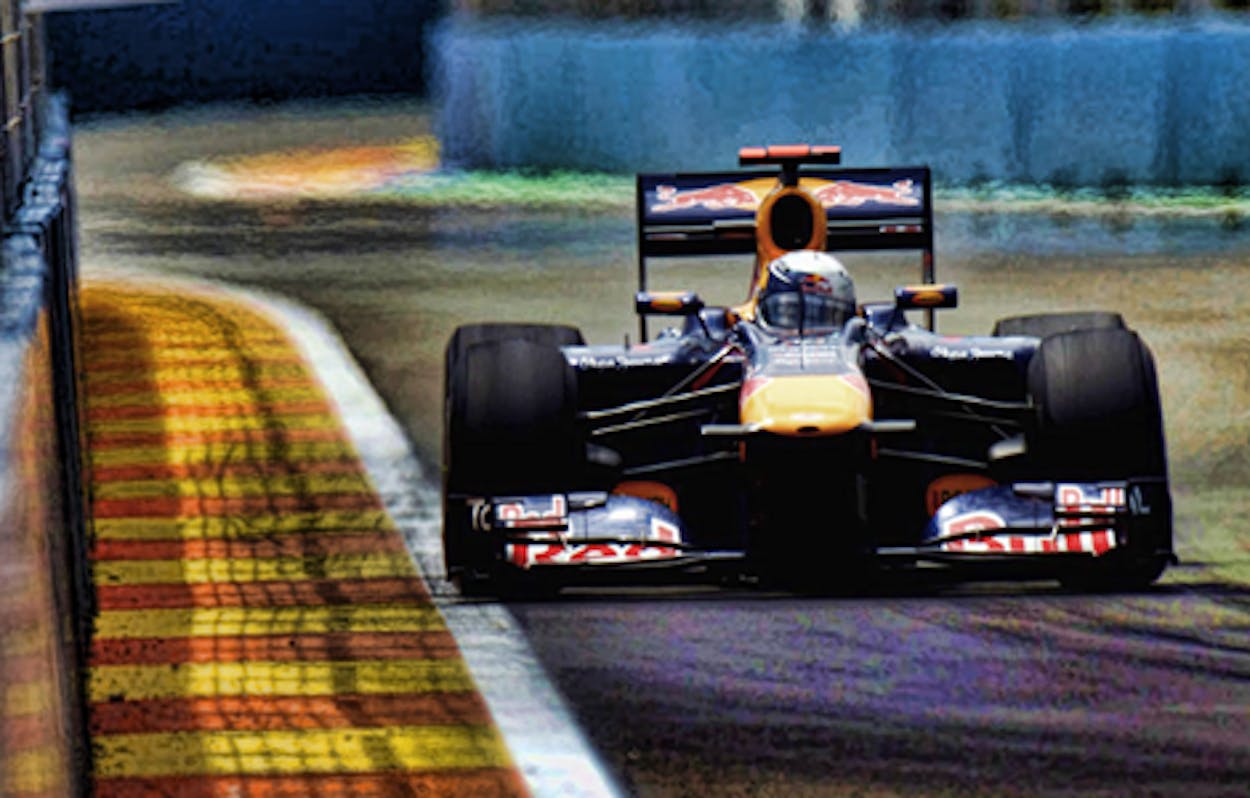The German driver Sebastian Vettel is dominating Formula One again this season, building on his 2010 championship with six wins in nine races. But that’s nothing compared to the underdog triumph that F1 itself just pulled: getting money from the state of Texas.
This month a group of promoters that includes Red McCombs, the former owner of the San Antonio Spurs, and Tavo Hellmund, a former racer and Austin native, is due to receive $25 million from the state’s Major Events Trust Fund, the first of ten annual subsidies that is meant to pay taxpayers back in the form of jobs, tourism, and other economic benefits.
How did this happen on the heels of a 2011 legislative session that doled out massive budget cuts to everything from education to the Texas film incentive fund? It didn’t. The bill that made F1 eligible for the events fund, which was created in 2004 to help attract events like the Super Bowl and Final Four, passed in 2009, and ground broke on the Circuit of the Americas, a 3.4-mile track that’s just southeast of Austin, on December 30, 2010.
“I think it’s a one-of-a-kind thing for our state,” said McCombs, who admitted to having little interest in the sport itself. “I enjoy seeing world-class events made possible. It’s the biggest thing in every country when it runs, except here, and we’ve never really given it a full course of its own. To me it’s a Super Bowl every year.”
Glamorous, expensive and high-tech, F1 combines the well-heeled vibe of the Kentucky Derby with the international popularity of soccer. It’s an odd fit for a state that prefers NASCAR and college football—but perhaps not for the state of J. R. Ewing and ExxonMobil. F1 honcho Bernie Ecclestone, with his silver shag, designer glasses and Alan Rickman-in-“Die Hard” demeanor, is — there’s no other word for it—Eurotrash. The British billionaire makes Jerry Jones look like Lady Bird Johnson. Can a Dodge/Ford/Chevy fan base get behind the circuit of McLaren-Mercedes, Ferrari and Renault, where one racer’s car has a Hugo Boss logo on the seat belt and everyone spells “tire” with a “y”? Or will we kick it to the kerb?
It almost doesn’t matter. Unlike, say, a hockey rink in Laredo, F1 is not supposed to be reliant on local dollars to succeed. Organizers say that at least sixty percent of the crowd will come from elsewhere, including a wealthy Mexican and South American contingent. And as far as F1 is concerned, “a racetrack is just a big television studio,” said Dave Kallmann, who covers racing for the Milwaukee Journal Sentinel. They want an American race to sell to advertisers, sponsors and world broadcasters. (F1’s only other North American track is in Montreal, which may as well be Europe.)
Just as nonfans manage to care about women’s soccer once every four years for the World Cup, or the IndyCar Series once a year for its namesake race, Texans would surely pay attention to a United States Grand Prix if it happened here. The biggest difference between F1 and the kind of racing the state’s fans are used to “is that the cars turn right,” said Matt Hardigree, the Houston-based news editor of the Gawker Media automobile blog Jalopnik. Unlike NASCAR’s oval, F1 tracks have turns and elevation changes, but less passing and less crashing. Like Indy, F1 is open-wheel racing, not the more popular stock car action. But F1 is a Mac compared to Indycar’s PC—more proprietary technology, more speed, more money.
“The great thing about Formula One that I think Texans will love is that it is really fast, really loud racing,” Hardigree said. “I think that what they won’t be used to is the fact that Americans suck at it.” (Phil Hill, in the 1960s, and Mario Andretti, in the 1970s, are the only American drivers to win F1 championships.)
If all goes well, the first United States Grand Prix is scheduled for June 17 of next year. The Austin American-Statesman has speculated that existing hotel capacity will—and may already be—booked all the way down to San Antonio. It’s a spectacle that wouldn’t have made sense in the Austin of “Slacker,” or remembering the Armadillo, but might in the Austin of the W Hotel and ACL. Hardigree predicted that race weekend will take over the city much like ACL or South by Southwest, with locals renting out their houses at inflated rates and Bentley-driving race fans fighting to get reservations at Uchi. “It’s a race that appeals to more affluent car enthusiasts, and Texas has a ton of affluent car enthusiasts,” he said.
Critics warn that if it doesn’t work, the only one who wins is Ecclestone. “Bernie always gets his money. Always,” Dutch Mandel of AutoWeek wrote in an “open letter” to Austin, which also included the advice, “Run away.” And Kallmann of the Journal Sentinel guessed that the chance of long-term success was still 50-50. “It’s not without its challenges,” McCombs conceded.
Big cars, big bucks, big risk. Nothing foreign about that.








